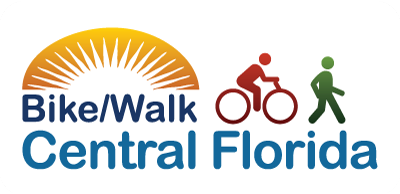Lyndy Moore dropped an egg, complete with a colored-on face and green hair into a pile of Styrofoam packing peanuts.
“This is the way a bike helmet protects your head,” she said. Then she picked up the egg (sealed in a small Ziplock bag) and dropped it on a tile.
SPLAT!
We all watched as the yellow yolk oozed through the now deformed face and into the bottom of the bag.
That demonstration was just a small part of a very important workshop, held this week at Bike/Walk Central Florida’s office. For four hours, a group of 8 people learned about Florida’s bike and pedestrian laws and became official helmet fitters—complete with a certification from the Florida Department of Transportation.
Lyndy knows how to make a four-hour training session fun. In addition to cracking several smiling eggs, her purple hair and infectious energy got people in the room excited about helping riders stay safe on their bikes. She shared a number of personal stories about the importance of bike helmets that made us all want to cry at times and laugh at others.
Lyndy works with a number of organizations and partners including Bike/Walk Central Florida and FDOT’s Alert Today Alive Tomorrow campaign to properly fit and give away free bike helmets. This diverse training group included an Orlando Police Bicycle Officer, an executive with the State Department of Health, the executive director of the Children’s Safety Village and two of our new outreach coordinators.
Helmet Fitting tips:
While this article won’t get you an official letter of certification, it contains great tips everyone should know.
- Measure around the person’s head, just above the ears—use that measurement to select the proper size of helmet.
- Place the helmet on the person’s head with the band parallel to the ground.
- Start with the left side, and the front strap. Tighten it until the buckle is right under the person’s ear. Have him or her hold the buckle in place.
- Move to the right side and tighten the back strap until the left side makes a tight “V”.”
- Then adjust the right side—front strap first, then back strap to get the same “V” shape.
- Have the person hold both buckles right under his or her ears while you adjust the chin strap.
- When finished, the helmet should be snug. It shouldn’t move if you push either the front or back up. It should still be parallel to the ground.
- Finger test: Have the person put two fingers on his or her forehead. The helmet should ride low enough for no more than 2 fingers. The chin strap should have no more than 2 fingers worth of room between the strap and the person’s chin.
- Yawn test: Have the person yawn. He or she should be able to feel the helmet touching the top of his or her head.
When to get a new helmet
- “One crash, then it’s trash,” is the motto for most helmets. Lyndy recommends cutting the straps of the helmet so no one else can use it. Because once it’s damaged, it won’t protect your head like it should.
- Check the tape that attaches the plastic to the Styrofoam. If there’s any damage or bubbling, it won’t protect you in a severe crash.
- If there are any cracks in the plastic, or it has warped from heat or humidity, get a new helmet.
- Look for damage in the Styrofoam that is on the exterior of the helmet. If it’s dented or cracked, throw your helmet away.

